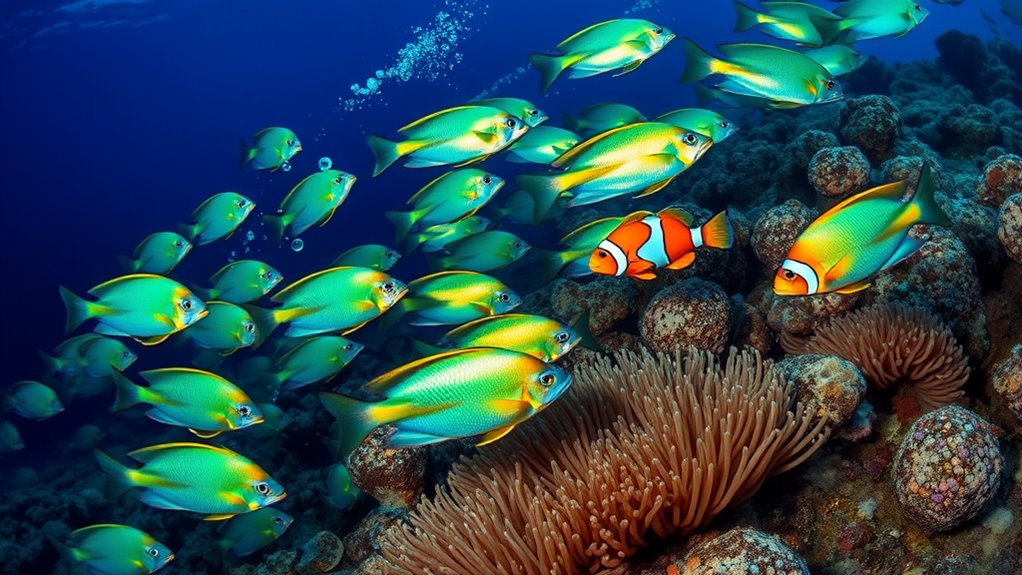Fish communicate underwater using a blend of visual cues and sounds. They perform vibrant displays during mating, showcasing colors and movements to attract partners. Territorial fish use signals like puffing up and aggressive posturing to defend their space. Sounds such as grunts and clicks enhance these interactions, making communication dynamic. This intricate way of signaling is essential for their survival and reproduction. There’s much more to uncover about the lively conversations beneath the waves.
Key Takeaways
- Fish communicate using a combination of visual signals, such as color changes and movements, particularly during mating rituals.
- Sound production, including grunts and clicks, plays a crucial role in social interactions among fish.
- Elaborate mating displays showcase health and vitality, attracting potential partners through vibrant colors.
- Territorial behaviors, such as aggressive posturing and puffing up, help fish establish and protect their personal space.
- Underwater communication is dynamic, involving both sounds and visual cues that enhance social interactions in aquatic environments.

Have you ever wondered how fish communicate beneath the waves? The underwater world may seem silent, but it’s teeming with chatter. Fish have developed a range of ways to interact, using both visual cues and sound. You might be surprised to learn just how intricate their communication methods are, especially when it comes to mating rituals and territorial signals.
When fish are ready to mate, they often engage in elaborate displays. You may observe vibrant colors or intricate movements that capture the attention of potential partners. For instance, during spawning season, male fish can change their colors dramatically, signaling their readiness. It’s like a colorful dance that you’d never expect to see in the depths of the ocean. These displays not only attract mates but also signal their health and vitality, indicating that they’re strong candidates for reproduction. If you watch closely, you’ll see how these mating rituals are essential for the survival of their species.
Aside from mating, fish also communicate through territorial signals. Every fish has its own space, and they’re quite protective of it. When a fish feels its territory is threatened, it’ll use various signals to ward off intruders. You might see a fish puffing up, changing colors, or even engaging in aggressive posturing to assert dominance. These actions aren’t just random; they’re part of a complex language that other fish can understand. It’s fascinating how these creatures establish boundaries and maintain their territories without any spoken words.
Sound is another indispensable aspect of fish communication. While some fish might not be able to produce sounds like whales or dolphins, they still make noises that can be heard underwater. These sounds can range from grunts and clicks to more complex sequences that convey different messages. You may not hear them from the shore, but beneath the surface, these sounds play an essential role in their social interactions. Understanding the importance of communication in different animal species can deepen our appreciation for their lives.
In the grand scheme of underwater life, fish communication is fundamental for their survival and reproduction. Whether through mating rituals or territorial signals, these creatures have adapted to convey their needs and intentions effectively. Next time you’re by the water, take a moment to appreciate the silent conversations happening just below the surface; you might find it’s more lively than you ever imagined.
Frequently Asked Questions
Do Fish Have Their Own Languages Like Humans Do?
No, fish don’t have languages like humans do, but they do communicate in fascinating ways. They use fish vocalizations, producing sounds to convey messages, especially during mating or territory disputes. Additionally, they rely heavily on visual signals, like body movements and colors, to express emotions or warn others of danger. So while their methods differ from ours, fish certainly have effective ways to interact and share information within their underwater world.
Can Fish Communicate With Other Species Underwater?
Fish can communicate with other species underwater through various means. Think of it as a vibrant underwater symphony; they use marine signaling and underwater vocalizations to convey messages. These sounds and signals help them warn others of danger, attract mates, or establish territory. While not as complex as human languages, this communication plays an essential role in the intricate web of life beneath the waves. So, next time you plunge in, listen closely!
How Do Environmental Factors Affect Fish Communication?
Environmental factors like water temperature and clarity can considerably affect fish communication. When you consider sound vibrations, you’ll notice that warmer water can enhance these vibrations, making it easier for fish to communicate over long distances. On the other hand, murky water can hinder sound travel. Chemical signals, like pheromones, can also be impacted by currents and temperature, influencing how effectively fish interact with one another. So, every aspect plays a role in their communication.
Are There Studies on Fish Communication in Aquariums?
Sure, you’d think fish in aquariums would just swim around in silence, right? Surprisingly, there are studies exploring their vocalizations and visual signals. Researchers observe how fish, in their watery prisons, use sounds and body language to communicate. These studies reveal fascinating insights into their social interactions and hierarchy, proving that even in the most controlled environments, fish have plenty to say—if only we could understand their gill-flapping chatter!
What Role Does Social Hierarchy Play in Fish Communication?
Social hierarchy plays a vital role in fish communication by influencing how they interact within their social structure. You’ll notice that dominant fish often use hierarchical signaling to establish their status and assert authority. This signaling can include postures, color changes, or specific movements. By understanding these dynamics, you can see how fish maintain order and reduce conflict, ensuring a balanced environment in their community. It’s fascinating how their social interactions shape communication!
Conclusion
So, next time you watch fish swim gracefully through the water, remember that they’re not just gliding along; they’re engaging in a complex conversation. Through body language, color changes, and sounds, these aquatic creatures share essential information with each other. Isn’t it fascinating to think about how much communication happens beneath the surface? By understanding their interactions, you gain a deeper appreciation for the underwater world and the intricate lives of its inhabitants.










